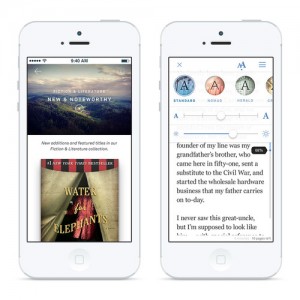 While Oyster is a great idea, and we’ve known an all-you-can-read type of subscription service was inevitable, is it the e-book subscription system to rule them all?
While Oyster is a great idea, and we’ve known an all-you-can-read type of subscription service was inevitable, is it the e-book subscription system to rule them all?
Sadly, I’m going to have to say, “no, not yet.” Now let me back that up.
You really have to evaluate a service like this based on three criteria
1. Price
2. Availability of books
3. Look and feel of the app
Let’s start with price. My husband and I have been debating this off and on for a couple of days now. I’m a 15-20 book a month reader. Realistically, I’d never do all my reading in Oyster, but 1/3 to 1/2 might be reasonable. $9.95 is a great value for me.
My husband looks at it from a different perspective, and I see his point of view as well. He compared it to Netflix, which runs $7.99 a month for a streaming plan. He posits that the average user will watch more movies and TV episodes in a month than read books, making Oyster, by comparison, quite expensive.
I’m a far more active reader than he is, so I’m going to stick with Oyster being a great deal for a voracious reader, the probable target of the service, providing the selection is adequate.
Which leads me to selection. It’s better than I had expected. No, you won’t find current bestsellers. However, I found several authors whose back list I’ve been meaning to read: J. A. Jance and Dennis Lehane. I also found several books by Jodi Picoult, who is one of those authors I like sometimes and can’t stand at others. Trying her stuff without buying them separately is attractive.
In about five to ten minutes of searching I found at least three months worth of reading. It’s fair to assume that will only improve over time. The selection won’t be for everyone, but I think most readers will be able to find plenty to keep them busy for months.
Which leaves the app itself, and it’s a deal breaker for me.
It’s only available on the iPhone, which means it will run on the iPad, but either in an iPhone sized screen or blown up to double-sized. The graphics didn’t pixelate badly, but the font was larger than I like. They did have some nice themes, which changed both font and text/background color. I liked “Crosby” which was a serifed font on a sepia background. When you login on both iPad and iPhone, the app remembers your location in the book.
All of those are nice features, and you can change font size, but that’s the limit of customization. It’s quite plain and limited as an e-reader app, and if you’re used to lots of extra features like in Marvin, Moon+ Reader or the like, you’ll be disappointed.
I could live with all of that, considering the value, if it weren’t for one feature that I can’t stand. You turn pages with an upswipe. On a phone, that’s not a bad motion, but I don’t like reading on my phone. Now that I own several tablets, in various sizes, I’ve grown accustomed to the larger screen, and an upswipe on a iPad is awkward for someone, like me, with small hands.
They say an iPad app is coming in the fall, and I’m willing to give them another try at that time, but launching with an iPhone-only app was, I think, a huge mistake. I suspect many other readers will feel as I do and decide to wait. If enough of us do that, their business model will break down.
Another mistake? They don’t have any immediate plans to create an Android app. Right now, Android is where all the 7-inch tablets are. 7 inches is the perfect size for e-reading. Yes, there’s the iPad mini, but I think they are missing a huge market by sticking to iOS only.
So, it’s a good service with a decent price and workable selection. Right now it’s hampered by reading platform. It remains to be seen if they can overcome that soon enough to survive.
































1. Without an Android app, I am not reading.
2. I feel like if I bought this, I would be compelled to only read on this app and not touch other things because I pay the money for this. Strangely, I do have Netflix and don’t mind paying the streaming for that, although more people than just myself are watching Netflix. So there are multiple users for the $7.99.
No Android, no deal.
Financially I think this could make sense for me as a reader but like Susan, I’d feel like I had to read only their stuff to make it worth my while. I’m not ready to do that.
I’d also have to consider how they compensate authors and I’ve yet to see that addressed though I’ve seen a lot of questions directed at them regarding the matter. It might just be me but I’m incredibly irritated that Smashwords is requiring their authors to opt out of this deal rather than letting them decide for themselves once they have had an opportunity to review the terms.
I was initially excited about this, but when I heard it was iPhone only I lost interest. I found reading books on my iPhone to be tedious—better than reading on my Palm Pilot, but still tedious. I became a voracious eBook reader when I bought the first gen iPad. I agree with you that releasing the iPhone only version first was a mistake. It seems to me they should have focused first on the iPad, then the iPhone, or held off releasing the app until it was universal.
Nice to see that everyone’s opinion so far matches mine. That iPhone only decision is going to hurt them. Badly.
I see no upside for authors in this. The only subscription services that have existed ended up putting all the money in the publishers’ pockets, and the authors never saw a penny. And, if the authors do get a decent cut, they’d have to have a hell of a lot of subscribers choose their books to make up the difference of even one book sale.
And, I haven’t been able to discover any of the details either.
Just knowing whether they pay the publisher in bulk without author names means the difference between whether the profits will go automatically to those who are bestsellers in paper because the authors are assumed to be the ones the readers want instead of the rest of the herd. Yet another stake in the heart to the midlist author who lacks the power to stop this kind of thing.
As to this price being too expensive in comparison to movie rentals, are you kidding me? That’s less than the average paper novel, and, unlike the movie and TV industry, the publishing industry and its authors only have the sale/lease of books as a means to make income, and it’s already damn pathetic in comparison. If Oyster and its ilk don’t offer a decent share of the income from this to publishers, they won’t get too many to offer their lists.
I have thought of only one good reason for Smashword authors to opt in. If they have a series of books, and they can opt in the first title but not the others, they may want to consider it. It would be the equivalent of a free book. Otherwise, run screaming in the opposite direction.
For those who have their books at Smashwords, what has this company said about percentages, etc.?
@Marilyn- That’s my complaint. Smashwords opted everyone in and all they’re saying is that the contract is “author friendly”. I need something a bit more than that to be comfortable with it.
I think this is a failure on two fronts.
1 – the iPhone only (and iOS only for the foreseeable future) eliminates a huge chunk of the market
2 – cost/value for the average person.
Most of us here are heavy readers but we are a very small niche.
The standard statistic we use in library land is 50% of the people will not read a book this year and 30 percent will read 2 or less.
With Amazon Prime for $80 a year you can borrow 12 books a year plus all the other things (streaming etc).
With Oyster you spend $120 a year. Going with the idea of the $9.99 price point that is 4 more books a year you can get at Amazon.
So you have to read at least 17 books a year, live in the US, only on iOS and only from a limited number of publishers.
I do not think that is a big enough market for a company to survive.
I too am waiting to see what the iPad app looks like.
On Smashwords: The opt-out issue isn’t peculiar to Oyster. Smashwords always does opt-out when it adds a new distribution channel. I recently sent an e-mail to their suggestion box about this; maybe if other folks do too, they might change this policy.
If this were the only way that you read e-books, would you say the Oyster is your world? 🙂
I’m joining the group that says ‘No Android, no go’.
@Chris, very cute. 😉 I might at that.
I was tweeting about this last night with Nate from Digital Reader. He had a perfect comment I wanted to share. “It’s never a good thing when potential customers complain about your refusal to do business with them.”
I agree. Oh, and Nate pointed out that the Oyster app has been updated to change the navigation feature. Tapping on the side of the screen now turns pages. Apparently I wasn’t the only one who hated the swipe up page turn.
Companies are foolish for not going with Android nowadays. They may start with iOS, but they need to have work in place for Android, too. And relatively quickly.
They also need to consider whether they can make it into the Kindle Android marketplace, too.